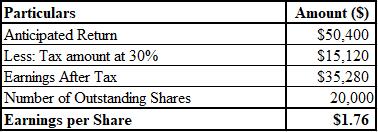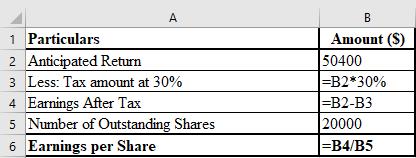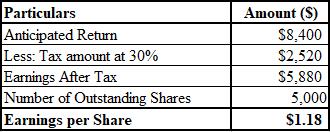
Assume that Atlas Sporting Goods Inc. has
a. Compute the anticipated return after financing costs with the most aggressive asset financing mix.
b. Compute the anticipated return after financing costs with the most conservative asset financing mix.
c. Compute the anticipated return after financing costs with the two moderate approaches to the asset financing mix.
d. If the firm used the most aggressive asset financing mix described in part a and had the anticipated return you computed for part a, what would earnings per share be if the tax rate on the anticipated return was 30 percent and there were 20,000 shares outstanding?
e. Now assume the most conservative asset financing mix described in part b will be utilized. The tax rate will be 30 percent. Also assume there will only be 5,000 shares outstanding. What will earnings per share be? Would it be higher or lower than the earnings per share computed for the most aggressive plan computed in part d?
a.
To calculate: The anticipated return, after deducting the finance costs, with the most aggressive approach of the asset financing mix.
Introduction:
Anticipated return:
It is the amount that an individual or company has estimated to earn from an investment. It is one of the factors taken into account by an investor before selecting an investment plan.
Aggressive approach:
When a company selects a plan of low liquidity with high return and long-term financing, it is termed as an aggressive approach.
Answer to Problem 11P
The anticipated return, after deducting the finance costs, with the most aggressive approach of the asset financing mix is $50,400.
Explanation of Solution
The calculation of the anticipated return is as follows.
Working notes:
The calculation of the return from the low liquidity plan is as follows.
The calculation of the finance cost of short-term financing is as follows.
b.
To calculate: The anticipated return, after deducting the finance costs, with the most conservative approach of the asset financing mix.
Introduction:
Conservative approach:
When a company selects a plan of high liquidity with low return and short-term financing, it is termed as a conservative approach.
Answer to Problem 11P
The anticipated return, after deducting the finance costs, with the most conservative approach of the asset financing mix is $8,400.
Explanation of Solution
The calculation of the anticipated return is as follows.
Working notes:
The calculation of the return from the high liquidity plan is as follows.
The calculation of the finance cost of long-term financing is as follows.
c.
To calculate: The anticipated return, after deducting the finance costs, with the two moderate approaches of the asset financing mix.
Introduction:
Moderate approach:
When a company selects a plan of low liquidity with high return and short-term financing or one of high liquidity with low return and long-term financing, it is termed as a moderate approach.
Answer to Problem 11P
The anticipated return, after deducting the finance costs, with the moderate approach of the low liquidity plan and long-term financing of the asset financing mix is $33,600.
The anticipated return, after deducting the finance costs, with the moderate approach of the high liquidity plan and short-term financing of the asset financing mix is $25,200.
Explanation of Solution
Anticipated return in the moderate approach of the low liquidity plan and long-term financing of the asset financing mix:
The calculation of the anticipated return is as follows.
Working notes:
The calculation of the return from the low liquidity plan is as follows.
The calculation of the finance costs of long-term financing is as follows.
Anticipated return in the moderate approach of the high liquidity plan and short-term financing of the asset financing mix:
The calculation of the anticipated return is as follows.
Working notes:
The calculation of the return from the high-liquidity plan is as follows.
The calculation of the finance costs of short-term financing is as follows.
d.
To calculate: The earnings per share if Atlas Sporting Goods Inc. uses the aggressive approach of the asset financing mix with the anticipated return computed in part (a).
Introduction:
Earnings per share:
It is a measurement of the company's profitability. It is calculated by dividing the net income less dividend paid for the prefernece stock by the average number of outstanding shares.
Answer to Problem 11P
The calculation of the earnings per share is as follows.

If Atlas Sporting Goods Inc. uses the aggressive approach of the asset financing mix with the anticipated return computed in part (a), its earnings per share is $1.76.
Explanation of Solution
The calculation of the earnings per share using Excel is as follows.

e.
To calculate: The earnings per share if Atlas Sporting Goods Inc. uses the conservative approach of the asset financing mix with the anticipated return computed in part (b) as well as to check whether it is higher or lower than the earnings per share computed in part (d).
Introduction:
Earnings per share:
It is a measurement of the company's profitability. It is calculated by dividing the net income less dividend paid for the preference stock by the average number of outstanding shares.
Answer to Problem 11P
The calculation of the earnings per share is as follows.

If Atlas Sporting Goods Inc. uses the conservative approach of the asset financing mix with the anticipated return computed in part (b), its earnings per share is $1.18.
The earnings per share by the conservative approach of the asset financing mix, that is, $1.18 is lower that by the aggressive approach of the asset financing mix, that is, $1.97.
Explanation of Solution
The formula used for the calculation of the earnings per share using Excel is as follows.

Want to see more full solutions like this?
Chapter 6 Solutions
BUS 225 DAYONE LL
- It is now January 1. You plan to make a total of 5 deposits of $500 each, one every 6 months, with the first payment being made today. The bank pays a nominal interest rate of 14% but uses semiannual compounding. You plan to leave the money in the bank for 10 years. Round your answers to the nearest cent. 1. How much will be in your account after 10 years? 2. You must make a payment of $1,280.02 in 10 years. To get the money for this payment, you will make five equal deposits, beginning today and for the following 4 quarters, in a bank that pays a nominal interest rate of 14% with quarterly compounding. How large must each of the five payments be?arrow_forwardDon't used hand raiting and don't used Ai solutionarrow_forwardDon't used Ai solution and don't used hand raitingarrow_forward
- (d) Estimate the value of a share of Cisco common stock using the discounted cash flow (DCF) model as of July 27, 2019 using the following assumptions Assumptions Discount rate (WACC) Common shares outstanding 7.60% 5,029.00 million Net nonoperating obligations (NNO) $(8,747) million NNO is negative, which means that Cisco has net nonoperating investments CSCO ($ millions) DCF Model Reported 2019 Forecast Horizon 2020 Est. 2021 Est. 2022 Est. 2023 Est. Terminal Period Increase in NOA FCFF (NOPAT - Increase in NOA) $ 1241 1303 1368 10673 11207 11767 1437 $ 12354 302 ✓ Present value of horizon FCFF 9918 9679 9445 ✔ 0 × Cum. present value of horizon FCFF $ 0 × Present value of terminal FCFF 0 ☑ Total firm value 0 ☑ NNO -8747 ✓ Firm equity value $ 0 ☑ Shares outstanding (millions) 5029 Stock price per share $ 40.05arrow_forwardDon't used hand raiting and don't used Ai solutionarrow_forwardDon't used hand raiting and don't used Ai solutionarrow_forward
- Don't used Ai solution and don't used hand raitingarrow_forwardQ1: Blossom is 30 years old. She plans on retiring in 25 years, at the age of 55. She believes she will live until she is 105. In order to live comfortably, she needs a substantial retirement income. She wants to receive a weekly income of $5,000 during retirement. The payments will be made at the beginning of each week during her retirement. Also, Blossom has pledged to make an annual donation to her favorite charity during her retirement. The payments will be made at the end of each year. There will be a total of 50 annual payments to the charity. The first annual payment will be for $20,000. Blossom wants the annual payments to increase by 3% per year. The payments will end when she dies. In addition, she would like to establish a scholarship at Toronto Metropolitan University. The first payment would be $80,000 and would be made 3 years after she retires. Thereafter, the scholarship payments will be made every year. She wants the payments to continue after her death,…arrow_forwardCould you please help explain what is the research assumptions, research limitations, research delimitations and their intent? How the research assumptions, research limitations can shape the study design and scope? How the research delimitations could help focus the study and ensure its feasibility? What are the relationship between biblical principles and research concepts such as reliability and validity?arrow_forward
- What is the concept of the working poor ? Introduction form. Explain.arrow_forwardWhat is the most misunderstanding of the working poor? Explain.arrow_forwardProblem Three (15 marks) You are an analyst in charge of valuing common stocks. You have been asked to value two stocks. The first stock NEWER Inc. just paid a dividend of $6.00. The dividend is expected to increase by 60%, 45%, 30% and 15% per year, respectively, in the next four years. Thereafter, the dividend will increase by 4% per year in perpetuity. Calculate NEWER’s expected dividend for t = 1, 2, 3, 4 and 5. The required rate of return for NEWER stock is 14% compounded annually. What is NEWER’s stock price? The second stock is OLDER Inc. OLDER Inc. will pay its first dividend of $10.00 three (3) years from today. The dividend will increase by 30% per year for the following four (4) years after its first dividend payment. Thereafter, the dividend will increase by 3% per year in perpetuity. Calculate OLDER’s expected dividend for t = 1, 2, 3, 4, 5, 6, 7 and 8. The required rate of return for OLDER stock is 16% compounded annually. What is OLDER’s stock price? Now assume that…arrow_forward
 EBK CONTEMPORARY FINANCIAL MANAGEMENTFinanceISBN:9781337514835Author:MOYERPublisher:CENGAGE LEARNING - CONSIGNMENT
EBK CONTEMPORARY FINANCIAL MANAGEMENTFinanceISBN:9781337514835Author:MOYERPublisher:CENGAGE LEARNING - CONSIGNMENT
